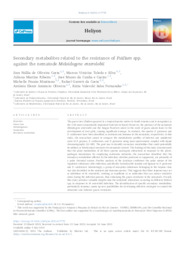Secondary metabolites related to the resistance of Psidium spp. against the nematode Meloidogyne enterolobii.
Secondary metabolites related to the resistance of Psidium spp. against the nematode Meloidogyne enterolobii.
Author(s): COSTA, S. N. de O.; SILVA, M. V. T. e; RIBEIRO, J. M.; CASTRO, J. M. da C. e; MUZITANO, M. F.; COSTA, R. G. da; OLIVEIRA, A. E. A.; FERNANDES, K. V. S.
Summary: The guava tree (Psidium guajava) is a tropical species native to South America and is recognized as the 11th most economically important fruit tree in Brazil. However, the presence of the nematode Meloidogyne enterolobii and the fungus Fusarium solani in the roots of guava plants leads to the development of root galls, causing significant damage. In contrast, the species P. guineense and P. cattleianum have been identified as resistant and immune to the nematode, respectively. In this study, the researchers aimed to compare the metabolomic profiles of infected and uninfected roots of P. guajava, P. cattleianum, and P. guineense using mass spectrometry coupled with liquid chromatography (LC-MS). The goal was to identify secondary metabolites that could potentially be utilized as biochemical resources for nematode control. The findings of the study demonstrated that the plant metabolism of all three species undergoes alterations in response to the phytopathogen inoculation. By employing molecular networks, the researchers identified that the secondary metabolites affected by the infection, whether produced or suppressed, are primarily of a polar chemical nature. Further analysis of the database confirmed the polar nature of the regulated substances after infection, specifically hydrolysable tannins and lignans in P. guineense and P. cattleianum. Interestingly, a group of non-polar substances belonging to the terpene class was also identified in the resistant and immune species. This suggests that these terpenes may act as inhibitors of M. enterolobii, working as repellents or as molecules that can reduce oxidative stress during the infection process, thus enhancing the guava resistance to the nematode. Overall, this study provides valuable insights into the metabolic alterations occurring in different Psidium spp. in response to M. enterolobii infection. The identification of specific secondary metabolites, particularly terpenes, opens up new possibilities for developing effective strategies to control the nematode and enhance guava resistance.
Publication year: 2023
Types of publication: Journal article
Unit: Embrapa Semi-arid Region
Observation
Some of Embrapa's publications are published as ePub files. To read them, use or download one of the following free software options to your computer or mobile device. Android: Google Play Books; IOS: iBooks; Windows and Linux: Calibre.
Access other publications
Access the Agricultural Research Database (BDPA) to consult Embrapa's full library collection and records.
Visit Embrapa Bookstore to purchase books and other publications sold by Embrapa.

